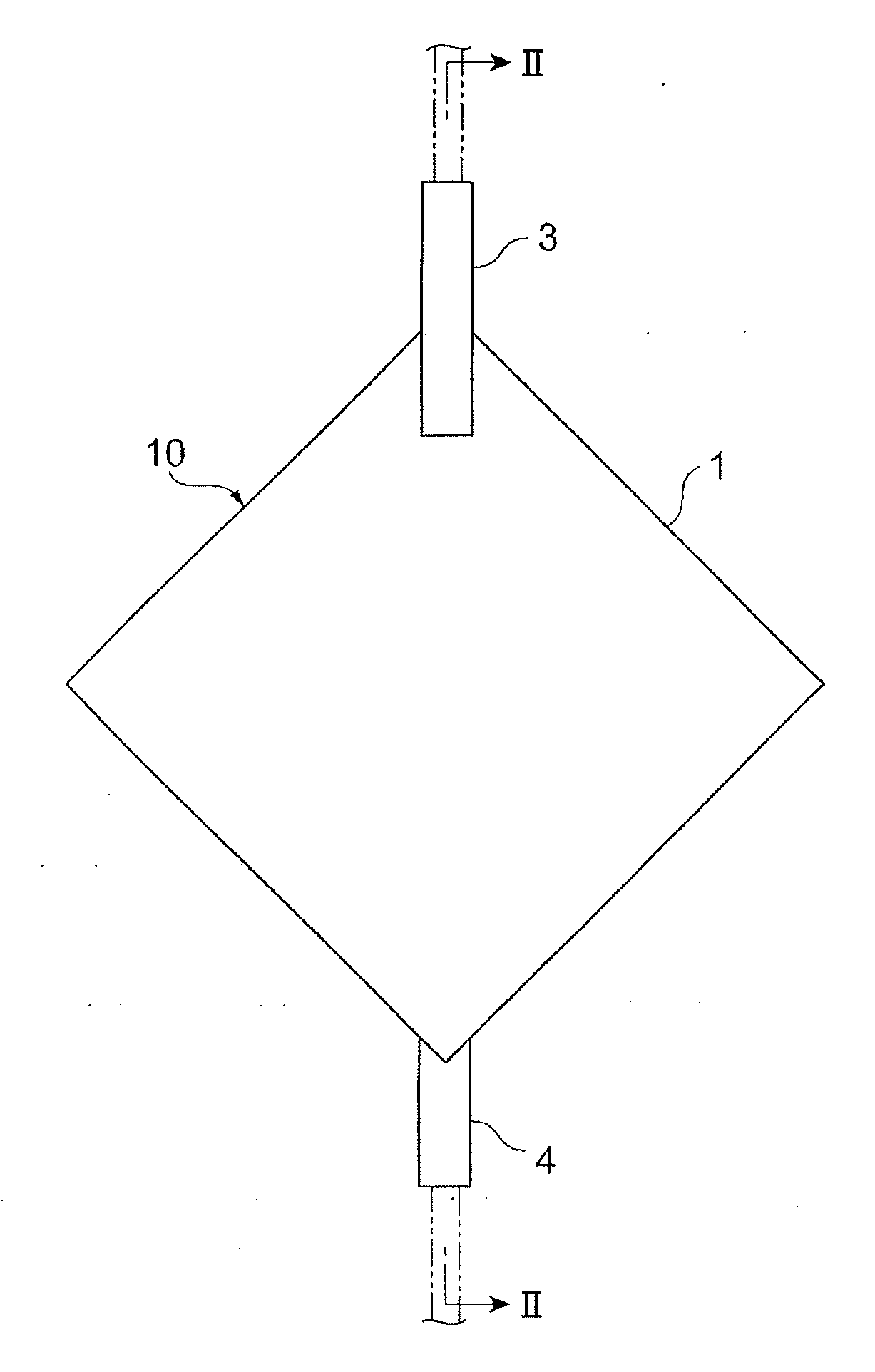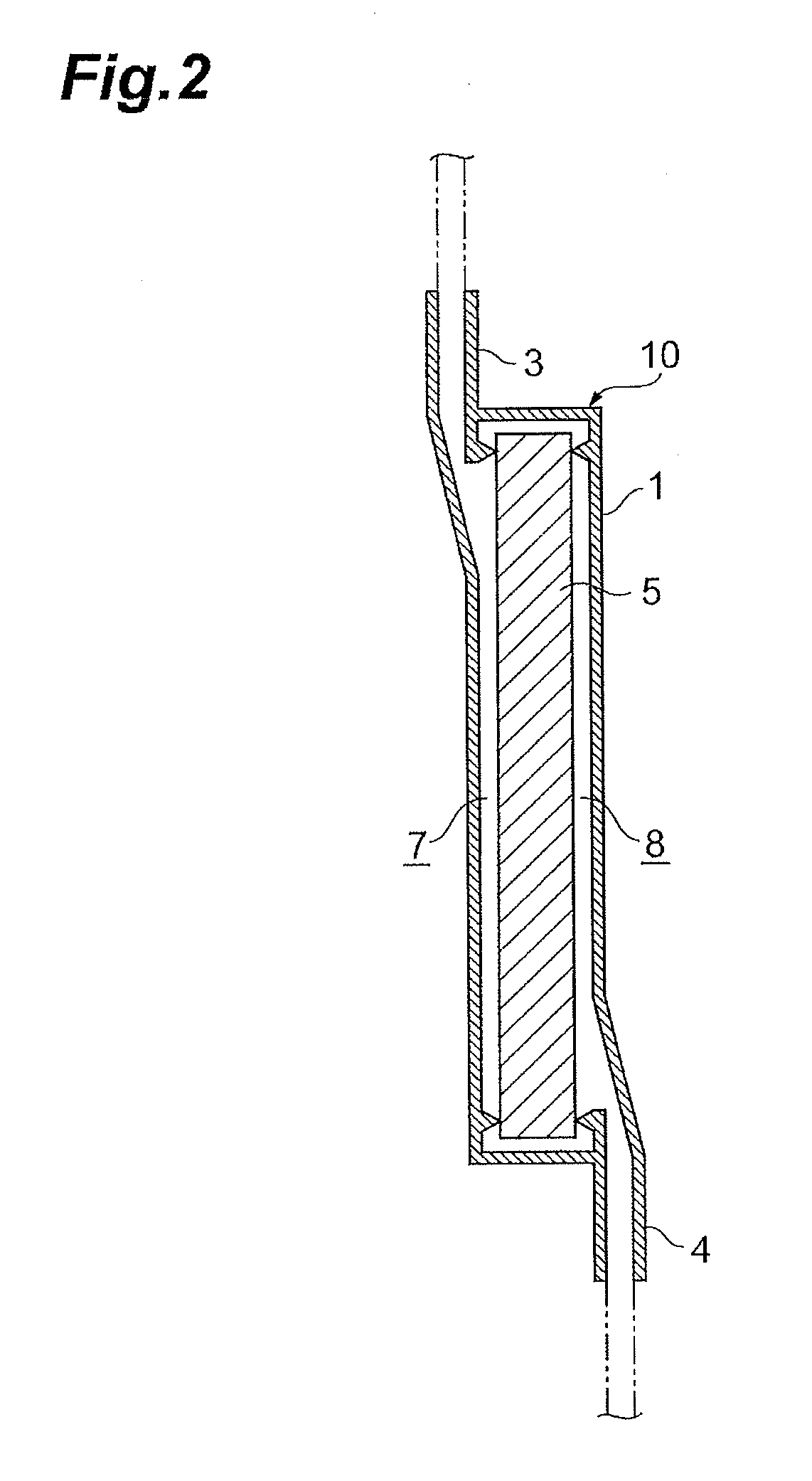Leukocyte removal filter material and leukocyte removal method
a filter material and leukocyte technology, applied in the direction of filtration separation, other chemical processes, separation processes, etc., can solve the problems of inability to recover and up in the garbage, and achieve the effect of improving the recovery rate and the processing speed
- Summary
- Abstract
- Description
- Claims
- Application Information
AI Technical Summary
Benefits of technology
Problems solved by technology
Method used
Image
Examples
example 1
[0130]A nonwoven fabric consisting of polybutylene terephthalate (hereinafter, abbreviated as PBT) fiber and having a mass per unit area of 22 g / m2, a thickness of 0.13 mm, a filling rate of 0.12, an average fiber diameter of 1.0 μm, and a formation index of 18.0 was used. The nonwoven fabric was prepared by a method of spinning polybutylene terephthalate by a melt blowing method to form a fiber assembly, and heat-treating the obtained fiber assembly at 140° C. for 120 seconds. The formation index of the nonwoven fabric was measured with a formation tester FMT-MIII (Nomura Shoji Co., Ltd.; manufactured in 2002; S / N: 130). The basic setting of the tester was not changed after the shipment from the factory, and the measurement was carried out such that the total number of pixels of a CCD camera was approximately 3400. The measurement of the formation index was carried out by setting the measurement size to 7 cm×3 cm (one pixel size=0.78 mm×0.78 mm) such that the total number of pixels...
example 2
[0141]A nonwoven fabric consisting of PBT fiber and having a mass per unit area of 23 g / m2, a thickness of 0.13 mm, a filling rate of 0.13, an average fiber diameter of 1.0 μm, and a formation index of 68.9 was used. The nonwoven fabric was prepared by a method of subjecting a fiber assembly after spinning to heat treatment in the same way as in Example 1. The same polymer coating treatment as in Example 1 was carried out to form a coat layer covering the PBT fiber. The CWST value after the polymer coating treatment was 100 dyn / cm. The nonwoven fabric after the polymer coating treatment was used as a leukocyte removal filter material. As a result of conducing the blood test by the same method as in Example 1, the leukocyte residual rate was 7.1×10−3, and the blood process pressure was 5.2 kPa, demonstrating a low blood process pressure and high leukocyte removal performance.
[0142]If the leukocyte residual rate becomes 10−4 or less, the number of residual leukocytes approaches the me...
example 3
[0143]A nonwoven fabric consisting of PBT fiber and having a mass per unit area of 22 g / m2, a thickness of 0.13 mm, a filling rate of 0.12, an average fiber diameter of 1.4 μm, and a formation index of 17.1 was used. The nonwoven fabric was prepared by a method of subjecting a fiber assembly after spinning to heat treatment in the same way as in Example 1. The same polymer coating treatment as in Example 1 was carried out for the nonwoven fabric. The CWST value after the polymer coating treatment was 100 dyn / cm. The nonwoven fabric after the polymer coating treatment was used as a leukocyte removal filter material. As a result of conducing the blood test by the same method as in Example 1, the leukocyte residual rate was 4.4×10−3, and the blood process pressure was 7.3 kPa, demonstrating a low blood process pressure and high leukocyte removal performance.
PUM
| Property | Measurement | Unit |
|---|---|---|
| diameter | aaaaa | aaaaa |
| thickness | aaaaa | aaaaa |
| area shrinkage percentage | aaaaa | aaaaa |
Abstract
Description
Claims
Application Information
 Login to View More
Login to View More - R&D
- Intellectual Property
- Life Sciences
- Materials
- Tech Scout
- Unparalleled Data Quality
- Higher Quality Content
- 60% Fewer Hallucinations
Browse by: Latest US Patents, China's latest patents, Technical Efficacy Thesaurus, Application Domain, Technology Topic, Popular Technical Reports.
© 2025 PatSnap. All rights reserved.Legal|Privacy policy|Modern Slavery Act Transparency Statement|Sitemap|About US| Contact US: help@patsnap.com



